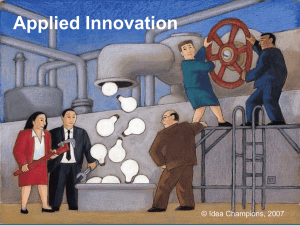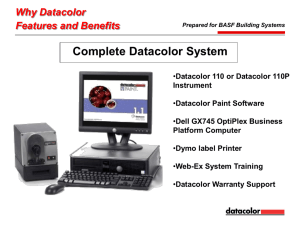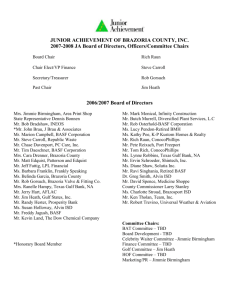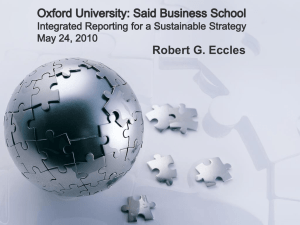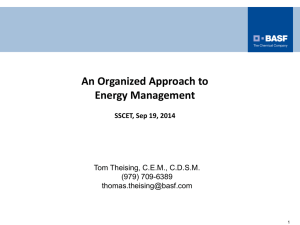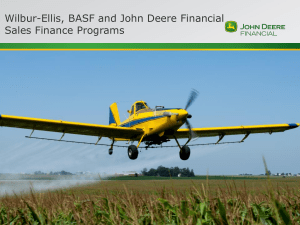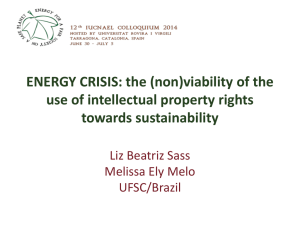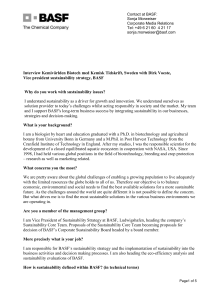BASF`s Eco-Efficiency Analysis - United Nations Global Compact
advertisement
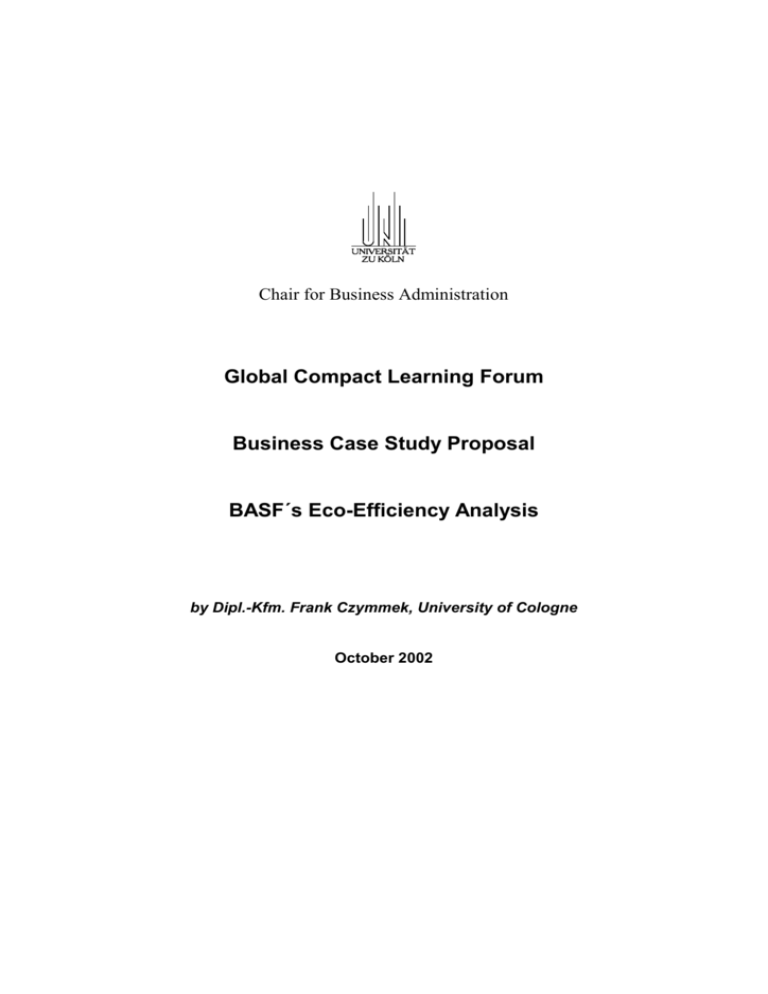
Chair for Business Administration Global Compact Learning Forum Business Case Study Proposal BASF´s Eco-Efficiency Analysis by Dipl.-Kfm. Frank Czymmek, University of Cologne October 2002 The BASF Eco-Efficiency Analysis 1. CASE ABSTRACT ............................................................................................ 2 2. COMPANY PROFILE ........................................................................................ 2 3. THE CASE STORY: BASF’S ECO-EFFICIENCY ANALYSIS .......................... 3 a) Statement of the problem to be solved....................................................................... 3 b) Identification of the motivation for the company to address this issue ................... 3 c) Identification of the key players and project development ....................................... 3 d) Link to stakeholder activity ......................................................................................... 4 e) Description of what happened .................................................................................... 4 f) Outcomes and impacts ................................................................................................ 4 A. Description of the eco-efficiency analysis system ..................................................................... 4 B. BASF’s eco-efficiency analysis relative to its international peers .............................................. 6 C. Stakeholder benefit ................................................................................................................... 7 I. Pilot project for improving the eco-efficiency of Moroccan dyeing factories .................................. 7 II. Project conducted in cooperation with mineral water manufacturers ........................................... 8 III. Project with the parliamentary fraction of Alliance 90/the Greens (Bündnis 90/Die Grünen) .... 10 4. UNRESOLVED ISSUES.................................................................................. 11 5. FUTURE OF THE ECO-EFFICIENCY ANALYSIS .......................................... 12 6. DATE OF PREPARATION AND CASE AUTHOR........................................... 12 7. APPENDIX: STUDIES, LITERATURE AND INTERVIEWS ............................ 13 Dipl.-Kfm. Frank Czymmek, University of Cologne 1 The BASF Eco-Efficiency Analysis 1. Case Abstract The topic of this business case study is BASF’s eco-efficiency analysis, a tool used by the company as a strategic instrument for integrated and balanced assessment of the economic and ecological aspects of products and processes. The issue addressed is the promotion of environmentally friendly products and processes in the chemical industry. The eco-efficiency analysis promotes Global Compact principles 7, 8 and 9 and is implemented throughout this global organization. The expert unit for the instrument is based in Ludwigshafen, Germany, and Mount Olive, New Jersey, USA. Currently (2002) BASF is partnering with UNEP and UNIDO in a project to disseminate the eco-efficiency analysis via National Cleaner Production Centers. Stakeholders in the projects are basically all those who stand to benefit from ecoefficient products and processes, primarily BASF’s customers, decision makers and internal business units as well as NGOs, NPOs and local interest groups. This study aims to identify the specific benefit for different stakeholders. 2. Company Profile BASF Group with its head offices in Ludwigshafen, Germany is a globally operating chemical corporation. BASF was set up in 1865. The organization's main business areas are chemicals, plastics and fibers, performance chemicals, agrochemicals, nutrition, oil and gas. BASF generated sales of 32.500 Million € in 2001 with its approximately 92.500-strong global workforce. Plastics and performance chemicals each accounted for one-quarter of total sales. The company posted net profits of 5.858 Million € after tax. Although sales were down slightly year-on-year, profits were well up on year-earlier figures. 55% of 2001 activities were in Europe, followed by North America (24%) and Asia (14%) (cf. www.basf.de/en/corporate/overview/jahresbericht/2001). BASF Aktiengesellschaft's environmental approach is based on proactive management and action, as can be seen in particular by its commitment to programs such as Responsible Care (a voluntary commitment of the global chemical industry for continuous improvement of services to environmental protection, safety and health), the establishment of a Sustainability Council, and, not least, by the many years spent in Dipl.-Kfm. Frank Czymmek, University of Cologne 2 The BASF Eco-Efficiency Analysis developing and implementing its eco-efficiency analysis tool. BASF is also a member of the World Business Council for Sustainable Development, a member of Global Compact, and is quoted on the Dow Jones Sustainability Index and the FTSE4GOOD Index. To find out more about BASF, please go to http://www.basf.com. To find out more about other sustainability related issues, please go to www.basf.de/en/corporate/sustainability/. 3. The Case Story: BASF’s Eco-Efficiency Analysis a) Statement of the problem to be solved The trigger for the development of the eco-efficiency analysis was the need to reconcile economic and ecological aspects in BASF’s corporate decision-making in relation to products and processes. b) Identification of the motivation for the company to address this issue The issue was raised because of the conviction that BASF would maintain its economic performance only if it succeeded in systematically integrating environmental aspects into its business strategy. BASF’s commitment to Sustainable Development and the demands of various stakeholders (customers, environmentalists) pointed in the same direction. Yet there was no specific action taken by stakeholders that ultimately led to the project. c) Identification of the key players and project development The BASF eco-efficiency analysis system was developed in 1996 in collaboration with Roland Berger + Partner business consultants. The project was initiated with the intention of creating a tool for analyzing products and manufacturing processes equally in terms of economic and ecological criteria. In addition the instrument had to be suitable for day-to-day business and provide a basis for effective communication with BASF’s customers. Roland Berger + Partner worked together with BASF experts from the Environment, Safety and Energy division, who contributed their knowledge of the ecological aspects of products and processes, and Planning and Controlling experts responsible for the strategic relevance of the instrument. The project was based on a joint deciDipl.-Kfm. Frank Czymmek, University of Cologne 3 The BASF Eco-Efficiency Analysis sion by the heads of the BASF divisions involved. Following a brief successful pilot phase, the eco-efficiency analysis system was institutionalized in a specialist unit within the Environment, Safety and Energy division. This unit now provides ecoefficiency analysis as a service to operational units throughout the BASF Group. d) Link to stakeholder activity See b) above and f) below. e) Description of what happened See c) above and f) below. f) Outcomes and impacts A. Description of the eco-efficiency analysis system The project resulted in a strategic analysis and decision-making tool as a means for guiding investment in product lines and processes based on a sound balance between ecological and economic criteria. The basis for analysis is a comparison of alternative products or processes that provide the same customer benefit. Each analysis is performed according to a predefined procedure. The starting point for each analysis is a defined customer benefit which the proposed product or process is intended to provide. The next step is to identify a set of options likely to provide this specific benefit. The eco-efficiency of these options throughout their life cycle is then analyzed. Economic analysis is from the end customer's point of view and is based on analysis of total cost throughout the life cycle. Ecologic impact analysis is based on six criteria: energy consumption, material consumption, surface requirement1, emissions, hazard and toxicity potential. Each of these six categories covers multiple individual criteria which are given a specific weighting in relation to each other. Weighting in a given instance is based on the one hand on factors with a social component such as public opinion surveys and local national environmental pollution, and on the other hand on quantitative factors based on statistical variables such as raw material impact. Each category is analyzed and assessed in relation to each option whereby the worst alternative scores 1 and the others are 1 Surface requirement was first factored into the eco-efficiency analysis system in 2001. The 'ecological fingerprint' generated in older analyses therefore has only 5 axes. 4 Dipl.-Kfm. Frank Czymmek, University of Cologne The BASF Eco-Efficiency Analysis ranked in relation to it. The scores are pooled to give an 'ecological fingerprint'. Cost factors are pooled in the same manner. The total outcome is then plotted on a twodimensional graph containing the scores for environmental pollution and cost. This 'eco-efficiency portfolio' now provides a basis for comparing the options in terms of their eco-efficiency. The simple final graph is one of the method's main advantages. The portfolio provides at a glance the data needed for informed decision-making. A sensitivity analysis completes the process. This sensitivity analysis shows different combinations of factors and presents the tolerance ranges pertaining to the advantageousness of the respective options. Numerous studies based on the method have been performed in recent years. These studies were used to compare existing products and processes with internal and external rivals. Decision-makers interpreted positive outcomes as vindicating an existing strategy, and adjusted, changed or scrapped individual products or chemical engineering processes in response to negative outcomes. The method was also used for ex ante analysis of investment in new areas; in this manner the ecoefficiency analysis system also served as a strategic decision-making tool. The BASF system is an extensive analysis tool for detailed investigation and evaluation of the ecological impact of products and processes in relation to their cost. The system has been used in more than 150 analyses for internal BASF purposes and external projects, and is the only eco-efficiency analysis method (in the world) certified by the German technological standards association TÜV Rheinland (cf. http://www.basf.de/en/corporate/sustainability/oekoeffizienz/aktuelles/). Below the benefits for external stakeholders will be shown. The internal benefits can be illustrated as follows: Most of the 150 analyses were conducted for internal decision making. The eco-efficiency analysis is used to compare new products and processes with already existing alternatives. The tool is used in order to find the best solution regarding a specific use. The impact on decision making can be shown by different examples. For instance one analysis provided the result that an innovative insulation material was much more eco-efficient than alternative BASF-products already established in the market. Therefore the further development of the new product was promoted and the investment in the existing products was reduced. Dipl.-Kfm. Frank Czymmek, University of Cologne 5 The BASF Eco-Efficiency Analysis In another study different forms of transport were compared with each other. The issue was the transport of chemicals from a supplier to a BASF-plant. On the basis of the results of an eco-efficiency analysis it was decided to use the railway. Finally there was an analysis of different manufacturing processes for Indigo which among other things is used to dye blue jeans. The company was planning to invest in a new production facility and there were three different alternatives to design the chemical production process. By choosing the process which was best according to the eco-efficiency analysis the sales of indigo were raised substantially. These examples show the impact of BASF’s eco-efficiency analysis for strategic decisions and the potential of the tool to improve the economic performance. The method, the results and the subsequent decisions have been communicated extensively both internally and externally. Using many different media, like printed publications, intra- and internet, the employees of BASF have been informed on many occasions. Yet to apply the tool a certain amount of expertise is required, e.g. for the collection of the relevant data. Because of this the eco-efficiency analysis is not an instrument to be used by every operating unit. It is conducted by a specialized service unit. B. BASF’s eco-efficiency analysis relative to its international peers The author of this paper analyzed numerous methods for measuring eco-efficiency. The primary focus was on the goals of the methods and the quantity and quality of the variables and criteria employed. The author concluded that the BASF eco-efficiency analysis tool is superior to its peers.2 This conclusion is based on the following facts: - It is an extensive tool for the analysis of products and processes throughout their life cycle - In terms of ecological and economic criteria, it uses the largest number of elements of relevance to an analysis of eco-efficiency - It is mainly based on quantitative data but qualitative material is also factored in The comparison included Dow Chemicals' "Eco Compass“, Bayer's "Eco Check", the "MIPS concept" of the Wuppertal Institute for Climate, Environment and Energy and the WBCSD concept. 6 Dipl.-Kfm. Frank Czymmek, University of Cologne 2 The BASF Eco-Efficiency Analysis - Analysis is based on computer-assisted evaluation - The method is in routine use and is by far the most widespread, having been used in the performance of some 150 studies C. Stakeholder benefit As the number of analyses grew, the company extended the scope of the system to focus on recipients other than internal BASF decision-makers. Focusing the analysis on a clear-cut, sharply defined customer benefit was instrumental in demonstrating the potential of the method for non-BASF applications. Hence, customers and consumers can be described as major stakeholders who stand to benefit from ecoefficiency analysis by purchasing products that meet top quality standards, cost less than rival products, and cause less environmental pollution than alternative products. Three projects are presented below which portray the benefits of the eco-efficiency analysis tool for external stakeholders. These projects and studies are not primarily intended to improve BASF’s operations and the involved stakeholders are not part of the company’s supply chain. Here the aim is to demonstrate the company’s commitment to the concept of eco-efficiency, to explore the benefits for others and to build trust by promoting environmentally responsible technology. I. Pilot project for improving the eco-efficiency of Moroccan dyeing factories This first example concerns a cooperation between BASF, two UN agencies, UNEP (United Nations Environmental Program) and UNIDO (United Nations Industrial Development Organization), and the Cleaner Production Center in Morocco. The objective was to support small and medium-sized enterprises (SMEs) in the Moroccan textile dyeing industry with the goal of promoting economically and ecologically sustainable production. The intention was to help these SMEs to meet international standards by improving and modernizing their production systems. An "Eco-efficiency Manager for Textile Dyeing Plants" was created on the basis of the eco-efficiency method. This manager facilitates analysis performance, giving SMEs access to the eco-efficiency analysis system and in this manner identifying a range of potential improvements for the Moroccan businesses in economical and ecological terms. The economic goal is to enhance competitiveness by optimizing Dipl.-Kfm. Frank Czymmek, University of Cologne 7 The BASF Eco-Efficiency Analysis production processes. The environmental impact goal is to use less water, energy and chemicals to produce the same outputs. This first case history shows what eco-efficiency analysis has to offer different direct and indirect target groups. On the one hand, many SMEs stand to benefit by having their products and processes studied by a computer-assisted method. These businesses usually do not have the financial and human resources to develop tools of their own for analyzing company structures and processes. As far as direct target groups are concerned, the information obtained can be used for example in setting up cooperative ventures between producers and their suppliers to link upstream and downstream elements of the value added chain in a quest to enhance eco-efficiency. This can also take place in the form of simultaneous engineering, with product and process developers working hand in hand. At the other end you have BASF's cooperation partners on the Moroccan project. The latter can be subsumed under the general heading of social target groups, and merit the more specific title of non-profit organizations. In keeping with their missions, UNIDO and UNEP theoretically pursue different ends. UNIDO is concerned with supporting and improving the market performance of businesses in the developing countries. UNEP's main concern is environmental policy. Ultimately, each organization represents the opposing elements of the eco-efficiency analysis method. Ecoefficiency analysis results in a win-win situation for both groups because it helps to develop the economy and improve the environment at the same time. The project was presented at the WSSD in Johannesburg. A detailed project description jointly published by the participating organizations can be found under http://www.basf.de/file/1212681.pdfnr2/Brochure_Morocco.pdf. II. Project conducted in cooperation with mineral water manufacturers The second case concerns a project commissioned by the Rhineland-Palatinate state government's ministry for environment and forestry which was conducted by BASF in cooperation with the mineral water manufacturers Gerolsteiner Brunnen, Hochwald Sprudel Schupp and Schmalbach-Lubeca. The objective of the study was to compare different packaging systems used for the distribution of mineral water for household use. The underlying customer benefit relates to the distribution of 1000 L of mineral water in a 200 km radius. The study anaDipl.-Kfm. Frank Czymmek, University of Cologne 8 The BASF Eco-Efficiency Analysis lyzed five different bottle sizes and shapes, including glass and PET bottles, disposables and returnables. Again, a number of stakeholders were integrated into the BASF eco-efficiency analysis process and the utility of the tool was identified in relation to their specific concerns. The benefit of the tool for businesses outside the BASF group (as seen in relation to the Moroccan project) is evident in this example also. The analysis enabled the mineral water manufacturers involved to test the environment-friendliness and cost efficiency of their production processes and implement the results in their corporate strategies. Again, the BASF analysis method demonstrated its potential as a service provided to third parties. Policymakers are another target group involved in the process. The RhinelandPalatinate state government acted primarily as the project initiator, but the implications of the analysis reach far beyond local or state borders. The results of the analysis - 1.) that recycling options with a high bottle return rate and effective reuse of materials produce the best results in terms of eco-efficiency and 2.) that deposit bottles were more eco-efficient than non-deposit bottles - coincided with public debate on the introduction of a deposit/return system for disposable beverage containers in Germany. This compulsory deposit/return system has since been adopted and will become law with effect from 2003. It is hard to determine the extent to which the results of this study had an actual bearing on the decisions made by the political institutions involved in drafting a compulsory deposit bill. Nevertheless, the data from the eco-efficiency analysis certainly had the potential to exert significant influence on the decision-making process. The method undoubtedly has huge potential for application in the preparation of draft bills. Current standard practice in similar processes is the use of ecological reviews analyzing the ecological impact of (in most cases) products throughout their life cycle. The eco-efficiency analysis system would enable analysts to factor in economic as well as ecological criteria, which would naturally confer a significant advantage in the political opinion-forming process. Dipl.-Kfm. Frank Czymmek, University of Cologne 9 The BASF Eco-Efficiency Analysis III. Project with the parliamentary fraction of Alliance 90/the Greens (Bündnis 90/Die Grünen) This refrigerator study with significant hands-on relevance to consumers was conducted in collaboration with Germany's Green party (Bündnis 90/Die Grünen). The aim was to compare the eco-efficiency of buying a new refrigerator or continuing to use an old one. The central issue involved was whether it makes more sense to use a product until the end of its life cycle or replace it with a more efficient model earlier on. The specific aim was to investigate whether it makes better economic and ecological sense to continue using a 10-year-old refrigerator or to buy a new one. Four different refrigerators were compared, two new and two old models. The BASF ecoefficiency analysis tool was used for evaluation. The outcome was that it may by all means be more rational in eco-efficiency terms to replace a functioning appliance before it reaches the end of its service life. The close relevance of the analysis to the end consumer in this case study highlights the benefit of the eco-efficiency analysis tool for the end consumer in his capacity as corporate stakeholder. The eco-efficiency analysis system can be used to support a vast range of decisions pertaining to the continued use or replacement of products. In addition to purely financial factors, the method also factors in the negative environmental impact associated with one or the other option. The end consumer thus benefits from a tool that supports the decision-making process in identifying ecoefficient products. He or she also has the option of acting on personal preference in the case of two basically equally eco-efficient alternatives, for example by deciding whether the relative ecological benefits of a new product offset its higher cost. Like the preceding project, this example demonstrates the method's political potential. The involvement of Bündnis 90/Die Grünen highlights the relevance of the analysis system in the political opinion-forming process. The results might also have much wider repercussions, if for example they are used for policy making or legislation. This example again serves to illustrate the already outlined benefit for other players in the value-added chain and for enterprises located outside the BASF Group. Finally, this case study indicates the potential of eco-efficiency analysis for research and development in general and for research institutes in particular. The eco- Dipl.-Kfm. Frank Czymmek, University of Cologne 10 The BASF Eco-Efficiency Analysis efficiency analysis tool can be used right at the start of product development to weed out alternatives that are less eco-efficient than already existing products. 4. Unresolved Issues The eco-efficiency analysis tool is always (and only) used as a basis for relative comparison between alternative options. Therefore, any resulting environmental benefit will also be relative. This fact cannot be ignored and effectively means that some elements of eco-effectiveness, i.e. of absolute environmental protection, must be left out of the equation. For example, as far as the specific case with the refrigerators is concerned, the basic issue of refrigeration is limited to conventional methods, i.e. refrigerators. The rights or wrongs of refrigeration per se are not factored into the analysis. Another critical point in the arguments for and against eco-efficiency analysis is the integration of the method in the concept of Sustainable Development. People often make the mistake of looking upon these two constructs as being on the same level, equating sustainability with eco-efficiency and vice versa. This attitude is wrong on two counts. For one, the BASF eco-efficiency analysis method covers just two of the three mainstays of Sustainable Development: economy and ecology. It does not embrace the third pillar of Sustainable Development: society. 3 For another, the method does not take steps toward achieving intragenerational and intergenerational justice. However, eco-efficiency analysis addresses two of the three pillars and in so doing indisputably represents a contribution to Sustainable Industrial Development. The BASF eco-efficiency analysis tool should therefore be interpreted as a necessary, but not yet sufficient, criterion for sustainability. The performance of an eco-efficiency analysis in itself is no guarantee that the final decision will be in favor of the more or most eco-efficient option. Any interpretation of the results presented in the eco-efficiency portfolio is colored by subjective factors. It is quite possible that a product identified as less eco-efficient will be chosen on cost grounds alone. The method does not allow a reduction of the analysis to purely objective factors. 3 A concept for integrating social aspects into the eco-efficiency analysis system is currently being developed in a Ph.D. thesis. 11 Dipl.-Kfm. Frank Czymmek, University of Cologne The BASF Eco-Efficiency Analysis Besides these unresolved issues and criticisms on the conceptual level, a drawback in terms of actual analysis is that the economic evaluation criteria are strictly monetary. The eco-efficiency analysis tool does not factor in qualitative criteria such as underlying tendencies and emotions affecting market performance. The issue here is whether the options identified as eco-efficient will actually perform well in the marketplace. Integration of these factors would introduce subjective variables into the evaluation of products and processes and allow consumer preferences and opinions to be included in the analysis. 5. Future of the Eco-Efficiency Analysis BASF is currently expanding the tool by trying to integrate social aspects in order to cover all three dimensions of sustainable development. By measuring economical, ecological and social impacts it is intended to transform the eco-efficiency analysis into the “socio-eco-efficiency-analysis”. By date a Ph.D. thesis deals with this development process. The thesis is part of a research project funded by the German Federal Ministry of Education and Research. Another important fact for the future is that BASF’s eco-efficiency tool is being made available to other organisations, too. BASF wants especially SME to use the method. Yet before they can apply the instrument they have to be trained by BASF to know how analysis works. Therefore the tool is in some regard to become publicly owned. 6. Date of Preparation and Case Author Cologne, November 2002 Dipl.-Kfm. Frank Czymmek Dipl.-Kfm. Frank Czymmek, University of Cologne 12 The BASF Eco-Efficiency Analysis 7. Appendix: Studies, Literature and Interviews Studies and literature BASF (1998): Studie Ökoeffizienz-Analyse Indigo-Färbung, Ludwigshafen 1998. BASF (1999): Studie Ökoeffizienz-Analyse Wärmedämmverbundsysteme, Ludwigshafen 1999. BASF (2000): Die Ökoeffizienz-Analyse der BASF, Ludwigshafen 2000. BASF (2000): Studie Ökoeffizienz-Analyse von Mineralwasserverpackungen, Ludwigshafen 2000. BASF (2001): Ökoeffizienz-Analyse Phthalocyanin-Pigmente für Druckfarben, Ludwigshafen 2001. BASF (2001): Studie Ökoeffizienz-Analyse Restmüllentsorgung, Ludwigshafen 2001. Dittrich-Krämer, B. (2002): Cross Sectoral Partnership, Presentation at the 3 rd Congress of Doktoranden-Netzwerk Nachhaltiges Wirtschaften “Beyond Johannesburg – Neue Wege für die Nachhaltigkeit”, October 2002.. Dittrich-Krämer, B./Kicherer, A. (2002): Ökoeffizienz-Analyse zu Neukauf oder Weiternutzung von Kühlschränken, in: Umweltwirtschaftsforum, Vol. 10, 2/2002. BASF/UNEP/UNIDO (2002): Eco- efficiency manager - An approach to sustainable industrial development, Ludwigshafen 2002. Kicherer, A. (2001a): Die Ökoeffizienz-Analyse der BASF, in: Umweltwirtschaftforum, Vol. 9, 4/2001, S. 57-61. Kicherer, A. (2001b): Die Ökoeffizienz-Analyse der BASF – Sustainable Development auf der Produktebene, Presentation at 4th Fresenius Umweltjahrestagung "Vom technischen Umweltschutz zum Nachhaltigkeit-Management", October 2001. Kicherer et al. (2000): Die Ökoeffizienz-Analyse nach BASF – ein Methodenpapier, Ludwigshafen 2000. Schrott, W./Saling, P. (2000): Ökoeffizienz-Analyse – Produkte zum Kundennutzen auf dem Prüfstand, in: Melliand Textilberichte, 3/2000. Dipl.-Kfm. Frank Czymmek, University of Cologne 13 The BASF Eco-Efficiency Analysis Interviews: Dr. Brigitte Dittrich-Krämer, BASF Sustainability Center Jörg Hartmann, BASF Sustainability Center Dr. Andreas Kicherer, BASF Ecoefficiency Group Bernhard Priesemuth, TÜV Rheinland, Berlin-Brandenburg (German industrial standards association) Dr. Peter Saling, BASF Ecoefficiency Group Isabell-Caroline Schmidt, BASF Ecoefficiency Group Silke Schmidt, BASF Ecoefficiency Group Prof. Dr. Günther Schock, TÜV Rheinland, Berlin-Brandenburg Dr. Winfried Zombik, BASF Ecoefficiency Group Dipl.-Kfm. Frank Czymmek, University of Cologne 14
